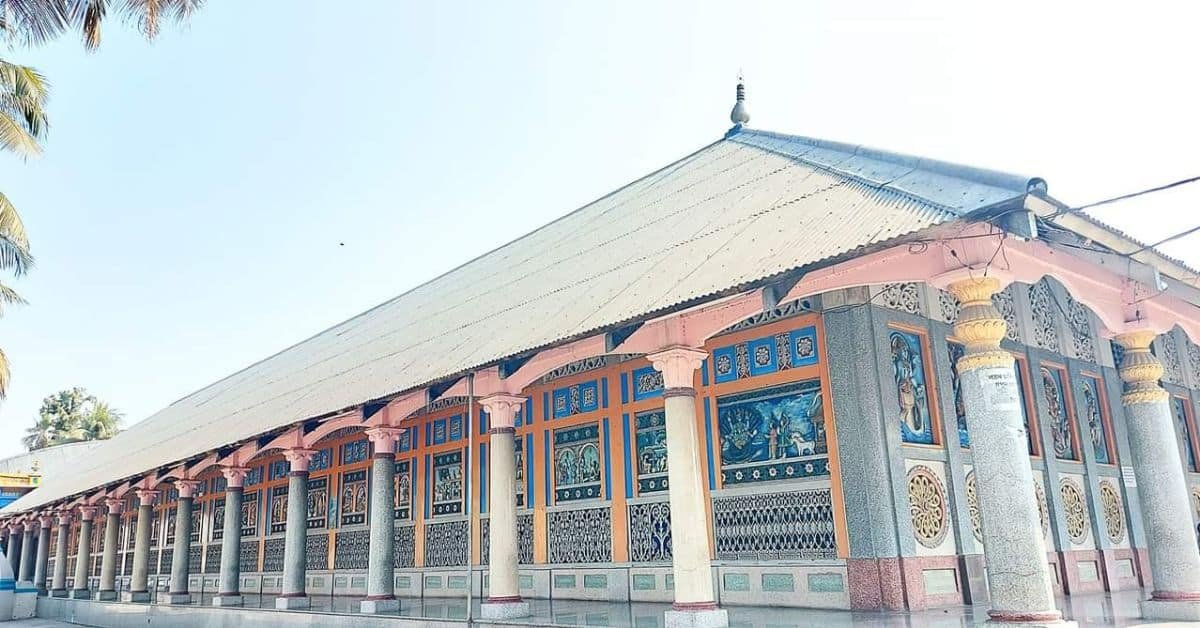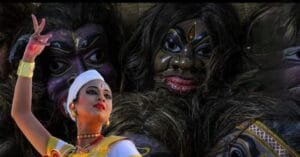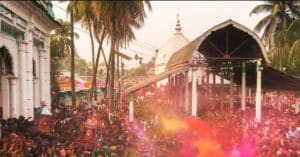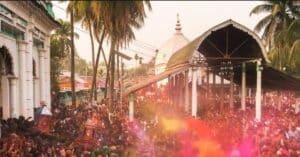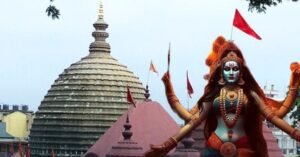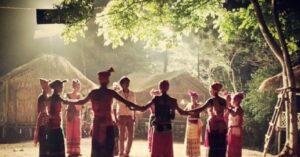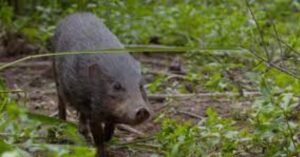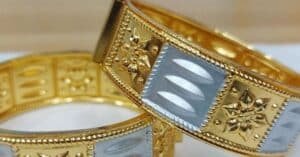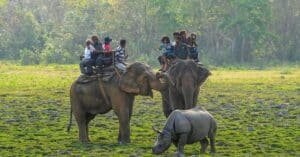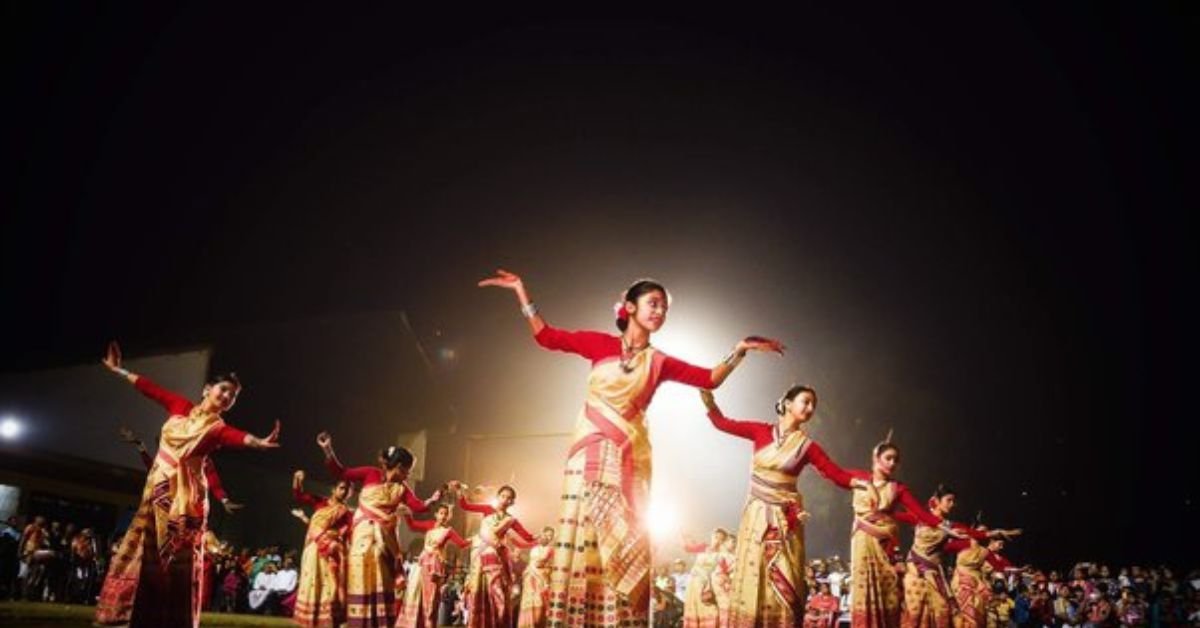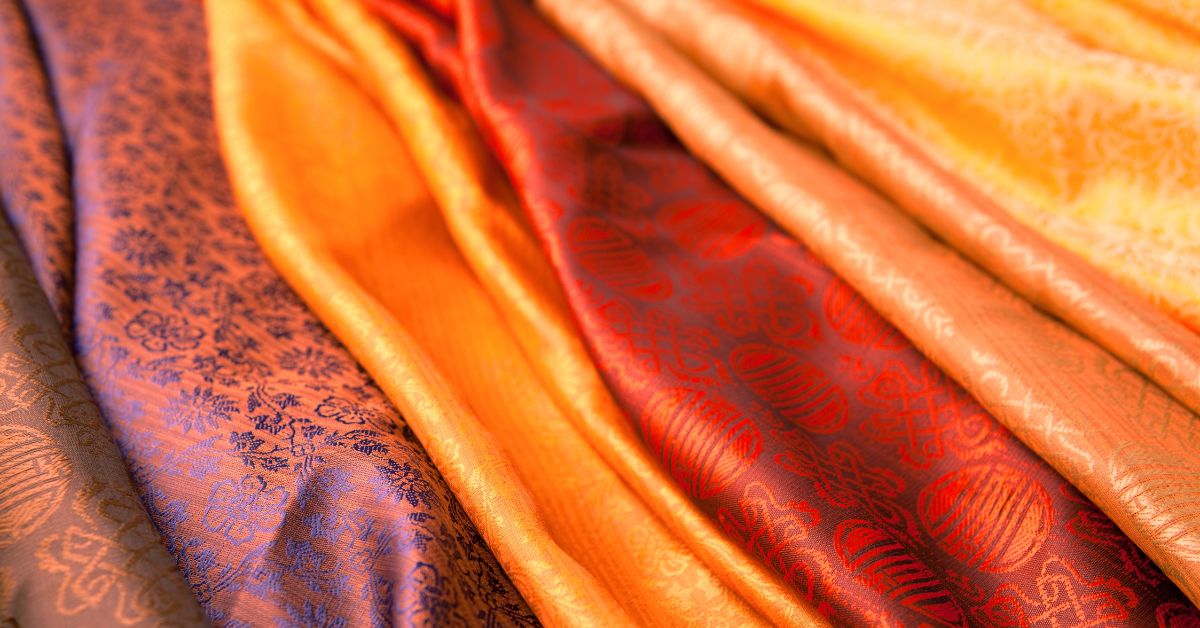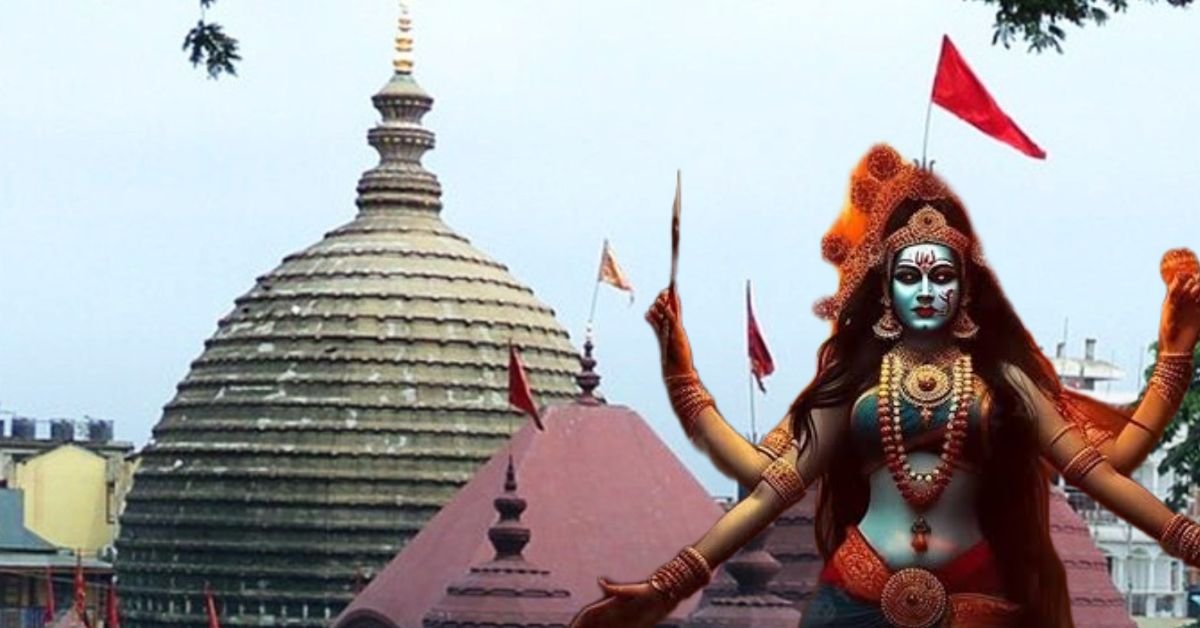The Barpeta district is Assam is known as the city of satras (satra-nogori). Satras are the monastic institution established by Mahapurush Srimanta Sankardeva and his disciples to propagate ne0-vaishnavite form of Hinduism (Ekasarana Dharma). The Barpeta Satra, located in the central part of Barpeta town, is renowned for its historical significance and is recognized as a pivotal center for the spread of Neo-Vaishnavism in lower Assam.
Barpeta Satra or the Barpeta Kirtan Ghar is the earliest and most influential satra of the mahapurusiya sect as well as the chief monastery of Assam.
What is Barpeta Satra famous for?
Barpeta Satra holds a distinguished reputation as the epicenter of Vaishnavite culture in Assam, playing a pivotal role in shaping the spiritual and cultural landscape of the region. This revered institution is particularly renowned for its annual Holi festival, drawing visitors from across Assam who seek a unique and enriching cultural experience. The spiritual ambiance of Barpeta Satra is further accentuated by its distinctive practices, including ‘palnam‘ (sacred congregational chanting), ‘nam prasanga‘ (devotional singing), ‘ankiya naat bhaona‘ (traditional Assamese plays), and ‘borgeet‘ (devotional songs).
History of Establishment
In the year 1504 CE, Madhavdev, a great disciple of Sankardeva, was at Sundaridiya (a place near Barpeta) continuing his mission to spread vaishnavite movement. Due to some reasons, Madhavdev decided to leave Sundaridiya to go to Bhawanipur satra and preach from Bhawanipur. Gopal Tanti (later on known as Mathuradas Burha Ata), however came to about Madhavdev’s plan and requested him to go to Tantikuchi (old name of Barpeta) instead of Bhawanipur. Gopal Tanti’s uncle Ram Laruwa Burha gifted a piece a land to Madhavdev to establish a kirtan ghar (a place of worship). The first kirtanghar at Barpeta was designed to be 180 ft. length and 90 ft. breadth and was established in 1505 CE.
Within a very short time span, this satra became the centre place for spiritual upliftment on the one hand and also a unique institution for practicing art and culture on the other hand.
Destruction of Original Kirtan Ghar and Building a New Satra
In 1594, the Barpeta Satra dwelling was unexpectedly consumed by a forest fire. During this calamity, Gopal Tanti was away in Bhawanipur. Upon his return, Gopal was overwhelmed with grief and sorrow. Seeking solace, Gopal approached Madhavdev, who was at Bhela Doba at that time. Encouraged by Madhavdeva, Gopal underwent a transformative experience, and his name was changed to Mathura Das Burha Ata. He was appointed as the first adhikara of Barpeta Satra. He then returned to Barpeta and diligently revitalized the satra on its scorched foundations. In 1595 A.D., he was formally crowned as the satradhikar (head of satra) of Barpeta Satra on the tithi (death anniversary) of Sankardeva.
Tragic Fate of Barpeta Satra
The kirtanghar reconstructed by Mathuradas Burha Aata was again burnt by fire and it was built again in 1828 AD. During the earthquake in 1897 AD it was again destroyed. In 1908-09 AD, it was rebuilt and the present construction was completed in 1962 AD.
Important Places Inside Barpeta Satra Complex
Barpeta Satra Complex consists of different parts like Kirttanghar (Prayer house), Bhajghar or Manikut (Sanctorum), Paatchang ( a raised wooden platform), Khatkhati (Staircase), Uddyan (Garden), Mathura Das Burha AtarBhithi (Residence of the first Satradhikar), Math, Mathar chotal (Courtyard of Math), Keolar baha (Residence of Bhakats/Monks), Office of the Management Committee, Rangamancha (Stage), Sabha Ghar (Meeting Hall), Deul, Jagmohan greeha, Satriya Samaskriti Prashikshan Vidyalaya (Cultural School), Badla Atar Bhithi (Residence of Badla Ata), Atithishala (Guest House),Bhagavata Kendra, Health Centre, Southern Gate, Northern Gate, Puthibharal (Library), office, Dalan (main gate), Rangiyal flower Garden, Shri Ram Atar bhithi (Residence of Ram Ata) and one small zoo comprised of deer and peacock. The Sattra compound covers approx 20 bighas of land.
The Barpeta Satra complex is surrounded by walls and there are three gates to enter the complex. The west gate also known as Dalan is the main gate for the tourists and visitors to enter Barpeta Satra.
Kirtan Ghar (Main prayer hall)

The Kirtan Ghar is centrally located within the Satra complex and is consistently oriented in an east-west direction. Notably, three Guru Ashans, dedicated to Sri Sankar Dev, Madhab Dev, and Mathura Das Burha Ata, are positioned at the end of the Kirtan Ghar. Behind the Guru Ashana in the east corner, two chairs are designated for Burha Satriya and Deka Satria, where their daily activities take place.

It is important to highlight that the Kirtan Ghar does not house any statues of deities; instead, it features sculptures of Garur and Hanuman. The exterior of the Kirtan Ghar is adorned with descriptions from Bhagavata and Purana on the north and south sides, while the west side depicts the Dasha Avatara of Vishnu.

Monikut or Bhaj Ghar
The Kirtanghar and the Manikut are essentially the integral parts of the Barpeta Satra. In local language, Monikut is called Bhaj Ghar. Monikut is compared to garbhagriha of a hindu temple. Unlike garbhagriha, no idol is displayed inside Monikut in Kiratanghar as Vaishnavite culture do not follow idol worship. However, inside the Monikut of Barpeta Satra, idol of Kaila Thakur (Lord Krishna) and Rukmini are placed. It is believed that the idol of Lord Krishna is kept in order to avoid royal wrath or to gain royal favour.

Do you know that there is an earthen lamp known as ‘Akshay Banti’ inside the Monikut of Barpeta Satra which has been in function continuously for more than 500 years?

Math

Doul Mandir

Festivals of Barpeta Satra
Since its establishment, Barpeta Satra has been the cultural center of Assam. Just like Satras of Majuli Island of Assam, the Barpeta Satra has been able to retain its age old tradition. Many of the festivals and programs at Barpeta Kirtan Ghar represents tradition and customs instituted by Sankardev and Madhavdev five centuries ago. Of all these festivals, the Doul Mahotsav (Holi), Bohag Bihu (Bohagor Damhi), Birth ceremony of Sri Sri Madhavdev, Tithi of Srimanta Sankardev- Sankardev Kirtan Mahotsav, Tithi of Sri Sri Madhavdev – Madhavdev Kirtan Mahotsav, Krishna Janmashtami, Magh Bihu (Maghor Damhi) are the most prominent.
Holi or Doul Mahotsab

Holi at Barpeta Satra stands out for its uniqueness. Comparisons are often drawn between the Holi celebration in Barpeta and those in Mathura and Vrindavan, Uttar Pradesh. uring this festive occasion, numerous visitors from various parts of Assam journey to Barpeta to take part in it and discover its traditions.
Locally known as Deul/Doul, the festival is being organised since the days of Sankardeva. Mahapurush Srimanta Sankardeva and his disciples initiated this festival. Later on, Mathura Das Bura Ata(then satradhikar of Barpeta Satra) popularised the festival among the masses.
During of the Holi festival in Barpeta depends on which Assamese month it is celebrated. If the festival falls on Sot/Chot month, it is celebrated for 3 days and is known as Burha Deul (translated to Holi for old age persons). If the festival falls on Faguun month, it is celebrated for 4 days and is known as Deka Deul (translated to Holi for youth).
You can read this blog for more about Holi celebration at Barpeta Satra
Bohag Bihu and Magh Bihu
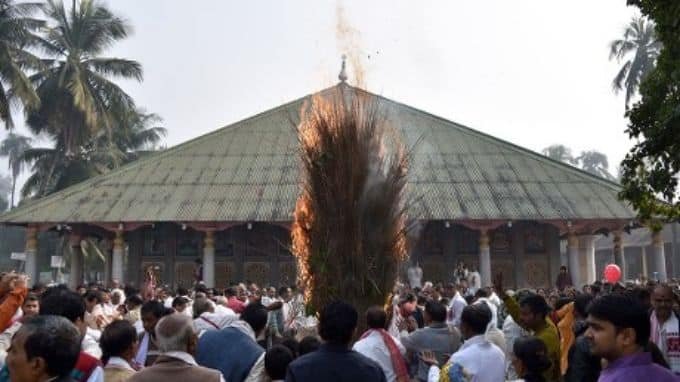
Just like other parts of Assam, Bihu is celebrated at Barpeta Satra with much fanfare and revelry. Unlike other Bihu programs, Bihu festival of Barpeta is more traditional and observed with utmost sincerity to tradition of the satra. The Bohag Bihu is a seven day long affair which starts on the last last of Assamese month ‘Sot'(mid-April). The Magh Bihu is a for day long event which start on the last day of Assamese month ‘Puh'(mid-January).
Other festivals of Barpeta Satra like Birth ceremony of Sri Sri Madhavdev, Tithi of Srimanta Sankardev- Sankardev Kirtan Mahotsav, Tithi of Sri Sri Madhavdev – Madhavdev Kirtan Mahotsav, Krishna Janmashtami are more of a religious ritual than festival. If you are a spiritual person, you can visit the satra on these occasions. The sound of cymbal, recitation of borgeet, rhythms of khol (a percussion instrument) will touch your soul and you will be blessed to witness these witness.

FAQs Regarding Barpeta Kirtan Ghar
Q: Who established Barpeta Satra?
A: Barpeta Satra was established by Mahapurush Madhavdev.
Q: When was Barpeta Satra Established?
A: Barpeta Satra was established in 1505 CE.
Q: Who was the first satradhikar (head of satra) of Barpeta satra?
A: Gopal Tanti alias Mathuradas Burha Ata was coronated as the first satradhikar of Barpeta satra on the tithi (death anniversary) of Sankardeva in 1595 CE.
Q: What is the best time to visit Barpeta Satra?
A: The best time to visit Barpeta Satra is during Doul Mahotsav or Holi. It is celebrated between the last week of March and the first week of April.
Q: Are women allowed inside main hall of Barpeta Kirtan Ghar?
A: According to tradition, women is not allowed to enter the Kirtan Ghar and Manikut Griha (sanctum sanctorum). However, barring these two places, women are welcome at all other places inside the satra complex.
Q: Can a women go to Barpeta Satra on her period?
Q: Though there are not any rules regarding this. It is considered inauspicious.

